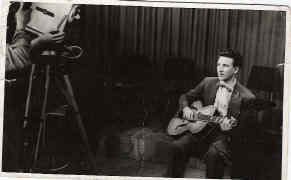 |
 |
|||||
|
|
|||||
|
The
Man: Bill Lawrence Musician The
Bill Lawrence story began literally in the rubble of World War II.
A
tall, skinny teenager from the outskirts of Cologne, Germany had
injured himself experimenting with a home-made rocket-propelled
bicycle and could no longer play his violin, so he took up a new
instrument: the electric guitar. Inspired by the records
of pioneer electric guitarists like Oscar Moore, Barney Kessel,
and recording innovator Les Paul, young Willi soon became
known as
"Hot Bill" for his uncanny ability to play guitar
solos with the high-speed drive of celebrated jazz players like
Charlie Parker and, in 1948, he already made his first pickup
to amplify his already-impressive sound so he could be heard
over the powerful horns and drums of post-war jazz bands! Within
a couple of years, Bill was enjoying a thriving career headlining
shows on American military bases mostly in Europe, on the same stages
as American stars ranging from Roy Acuff and Hank Williams to Dinah
Washington and Sam Cooke. Bill's performing life continued to flourish
through the
'50s, initially going by the stage name "Billy
Lorento" and becoming the
first major endorser of German-made Framus guitars and strings
with his own signature model. By the early '60s, his professional
name had permanently become "Bill Lawrence," and he formalized his
commitment to the great American guitars he'd always loved by signing
on as a
Fender endorser. Designer In the mid-'60s, Bill, with two partners, started a company in Germany, Lawrence Electro Sounds, offering his designs "Lawrence True-Sound Pickups" to the German guitar manufacturers. Bill came to America in the late '60s, quickly becoming established in the thriving music scene of New York's Greenwich Village. His innovative Lawrence Audio electric piano became a favorite of artists ranging from Stevie Wonder to Miles Davis. He designed pickups for MicroFrets, and he teamed up with fellow electric guitar wizard Dan Armstrong on several projects, eventually taking over Dan's custom shop when Dan moved to England -- a true mecca for New York's most demanding players. It was there that Bill continued his work of rebuilding pickups to eliminate their internal flaws, flaws he'd discovered over many years as a player striving to improve his own guitars. He also developed new pickups for retrofitting into existing guitars, thus essentially inventing the aftermarket replacement guitar pickup. Among Bill's apprentices in those days were Dan Armstrong's teenaged son, Kent, and a local kid named Larry DiMarzio.
Bill's
exceptional reputation in New York soon caught the attention of
Gibson,
who lured him away with a contract as a guitar and pickup designer,
eventually putting him in full charge of design at their famed Kalamazoo,
Michigan factory. There, Bill immediately applied what he had learned
over the years, revolutionizing both the efficiency and consistency
of Gibson's pickup department as well as designing instruments that
are among the best (and best-kept secrets) in Gibson's
storied history, including the remarkably
versatile L6-S solid-body guitar and the unique lightweight Ripper
bass.
While
maintaining his consulting relationship with Gibson, by the mid-'70s
Bill had moved to the Nashville area at the suggestion of his friend
Chet Atkins. There, he introduced
the very successful FT-145 soundhole pickup for acoustic guitars,
the first noisefree pickup in Fender single-coil size -- the single-blade
L-220, his legendary L-90 twin-blade humbucker, and later the L-500
series. The L-500 recently became the very first aftermarket pickup
design to be reverse-engineered by a major aftermarket maker. Bill's
Nashville designs also included his famous solderless high-performance
guitar plugs and cable (also reverse-engineered by others in recent
years), and Long-Life strings made with a process that remains unsurpassed
in the industry today. The
'90s found Bill, now teamed with wife (and skilled pickup maker)
Becky, still innovating -- his L-280
noisefree" series for Strats and Teles helped bring these
American classics into the twenty-first century, and Fender
had engaged him as a consultant. This
long-running relationship, which included designing the pickups
for Fender's highly successful Roscoe
Beck signature basses, has most recently resulted
in the SCN
(samarium cobalt noiseless) pickup
family found in the prestigious and popular American Deluxe series
of Fender guitars and basses. Today,
Bill
and Becky
continue to offer players consistent quality and innovation
under
Bill Lawrence Pickups, including WildeUSA™
and Keystone™ .
One of Bill's guiding principles is to constantly improve the performance
and value of the products he designs and endorses -- that means
that Bill's WildeUSA and Keystone pickups available today
represent the very best work of one of the industry's legendary
pioneers. Bruce Morgen is a veteran technical writer and musician who's known Bill Lawrence since the early '70s, when both men worked with singer-guitarist Bobby Hebb in New York -- Bruce as a sideman with Bobby, and Bill making sure Bobby's guitars played and sounded perfect.
|